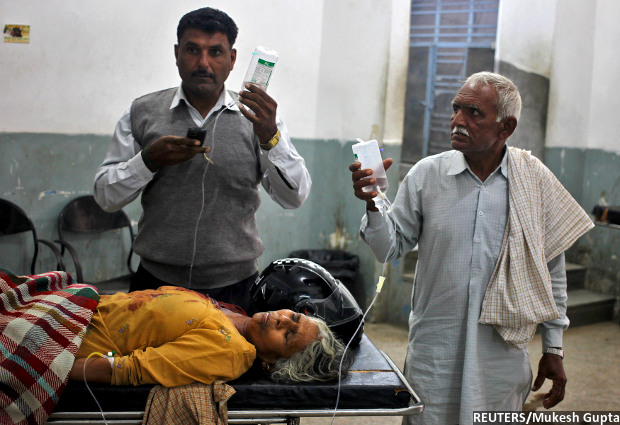India Better Than Only Pakistan Among 19 Neighbours In Improving Health Access
India did better only than Pakistan over 15 years to 2015 among 19 countries in South and Southeast Asia (including China) by potential and actual healthcare access and quality.
The second largest and the fastest growing economy in the region, India saw its gap widening by 5.5 points, 1.4 points less than Pakistan, in 1990-2015, according to an IndiaSpend analysis of the Healthcare Access and Quality (HAQ) Index published in The Lancet, a British medical journal.
The median country in the region, Laos--10th among the 19 countries--saw its gap narrow by 3.5 points in 15 years. Thailand, the top country in the region, narrowed its gap by 8.1 points in the same period.
The study--published on May 18, 2017--argued that inequality between states and the health sector that has failed to keep up with changing trends in diseases could be responsible for the widening gap in countries like India.
The gap narrowed globally by 1.1 points and the index rose from 40.7 in 1990 to 53.7 in 2015.
The index goes from 0 to 100: the higher a country’s value, the better.
The study used a socio-demographic Index consisting of income per capita, average years of education and total fertility rates and the HAQ index to calculate “the maximum levels of personal health-care access and quality achieved” at a level of development. This helped quantify the difference between a country’s HAQ index and the highest value the index could attain given the country’s stage of development in 1990 and 2015.
The change in that gap from 1990 to 2015 was used to calculate this ranking.
For instance, Turkey tops the chart as it has the moved greatest distance (14.2 points) in the direction of closing the gap (hence negative sign), while Lesotho is at the bottom as it has slipped the greatest distance (21.1 points) away from its potential (hence positive sign) in the 15 years to 2015.
“If every country and territory had achieved the highest observed HAQ Index by their corresponding level of [development], the global average would have been 73.8 in 2015,” the study noted.
“Several countries, particularly in eastern and western sub-Saharan Africa, reached HAQ Index values similar to or beyond their development levels whereas others, namely in southern sub-Saharan Africa, the Middle East, and south Asia, lagged behind what geographies of similar development attained between 1990 and 2015.”
India at the bottom in BRICS group, 178th among 195 countries
India was at the bottom of the BRICS group (Brazil, Russia, India, China and South Africa), with the median country, Russia (third among the five countries), narrowing its gap by 3.3 points over the 15 years to 2015. China topped, narrowing its gap by 5.5 points in 1990-2015.
Source: Lancet study
For data on 195 countries evaluated in the study, click here.
India, along with Djibouti and Kenya, stood 178th among the 195 countries surveyed. The median countries (ranked 98th)--Azerbaijan, Antigua and Barbuda, and Montenegro--saw their gaps narrow by 2.3 points in 1990-2015.
Countries worse than India included Mozambique (181th), Honduras (184th), Iraq (190th), Zimbabwe (191st) and Oman (193rd), which saw their gaps widening by 5.8, 6.4, 7.9, 10 and 13.3 points, respectively.
Source: Lancet study
For South Asia--comprising Bangladesh, Bhutan, India, Nepal and Pakistan--the gap widened by 4.1 points over 15 years even as the index rose from 30.7 in 1990 to 44.4 in 2015.
For Southeast Asia--comprising Cambodia, Indonesia, Laos, Malaysia, Maldives, Mauritius, Myanmar, Philippines, Sri Lanka, Seychelles, Thailand, Timor-Leste and Vietnam--the gap widened by 1.5 points and the index increased from 38.6 in 1990 to 52.1 in 2015. (The study clubbed China with North Korea and Taiwan under East Asia.)
Creaky public health infrastructure leave poor to fend for themselves
Inadequate public infrastructure--the private sector accounts for 63% of hospital beds--and concentration of healthcare professionals around urban areas has left the poor to either fend for themselves or depend on non-governmental initiatives, IndiaSpend reported (click here, here, here, here, here, here, here, here, here, here and here).
Access to quality healthcare in rural areas also depends on location with even poor households able to access better services if they live in richer villages, according to this 2016 research report by Jishnu Das, a World Bank economist, and Aakash Mohpal, an economics PhD candidate at the University of Michigan, Ann Arbor, US.
(Vivek is an analyst with IndiaSpend.)
We welcome feedback. Please write to respond@indiaspend.org. We reserve the right to edit responses for language and grammar.
__________________________________________________________________
“Liked this story? Indiaspend.org is a non-profit, and we depend on readers like you to drive our public-interest journalism efforts. Donate Rs 500; Rs 1,000, Rs 2,000.”



